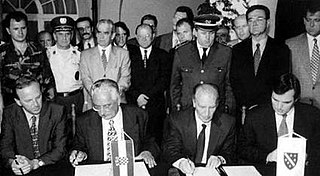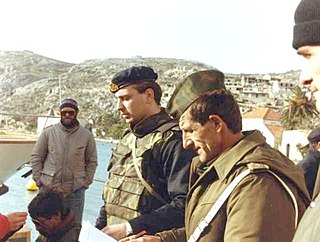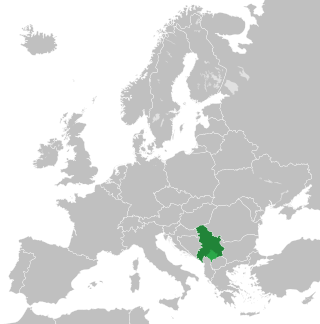Related Research Articles

The siege of Sarajevo was a prolonged blockade of Sarajevo, the capital of Bosnia and Herzegovina, during the Bosnian War. After it was initially besieged by the forces of the Yugoslav People's Army, the city was then besieged by the Army of Republika Srpska. Lasting from 5 April 1992 to 29 February 1996, it was three times longer than the Battle of Stalingrad, more than a year longer than the siege of Leningrad, and was the longest siege of a capital city in the history of modern warfare.

Alija Izetbegović was a Bosnian politician, Islamic philosopher and author, who in 1992 became the first president of the Presidency of the newly independent Republic of Bosnia and Herzegovina. He later served as the first chairman of the Presidency of Bosnia and Herzegovina.

The Bosnian War was an international armed conflict that took place in Bosnia and Herzegovina between 1992 and 1995. The war is commonly seen as having started on 6 April 1992, following a number of earlier violent incidents. The war ended on 14 December 1995 when the Dayton accords were signed. The main belligerents were the forces of the Republic of Bosnia and Herzegovina, the Republic of Herzeg-Bosnia, and the Republika Srpska, the latter two entities being proto-states led and supplied by Croatia and Serbia, respectively.
The Death of Yugoslavia is a BBC documentary series first broadcast in September and October 1995, and returning in June 1996. It is also the title of a BBC book by Allan Little and Laura Silber that accompanies the series. It covers the collapse of Yugoslavia, the subsequent wars and the signing of the final peace accords. It uses a combination of archived footage interspersed with interviews with most of the main players in the conflict, including Slobodan Milošević, Radovan Karadžić, Franjo Tuđman and Alija Izetbegović, as well as members of the international political community, who were active in the various peace initiatives.

Warren Zimmermann was an American career diplomat best known as the last US ambassador to SFR Yugoslavia before its disintegration in a series of civil wars. Zimmermann was a member of the Yale Class of 1956, and a member of Scroll and Key Society. He died of pancreatic cancer at his home in Great Falls, Virginia on February 3, 2004.
The Yugoslav Wars were a series of armed conflicts on the territory of the former Socialist Federal Republic of Yugoslavia (SFRY) that took place between 1991 and 2001. This article is a timeline of relevant events preceding, during, and after the wars.
The foreign policy of the Bill Clinton administration was of secondary concern to a president fixed on domestic policy. He relied chiefly on his two experienced Secretaries of State Warren Christopher (1993–1997) and Madeleine Albright (1997–2001), as well as Vice President Al Gore. The Cold War had ended and the Dissolution of the Soviet Union had taken place under his predecessor President George H. W. Bush, whom Clinton criticized for being too preoccupied with foreign affairs. The United States was the only remaining superpower, with a military strength far overshadowing the rest of the world. There were tensions with countries such as Iran and North Korea, but no visible threats. Clinton's main priority was always domestic affairs, especially economics. Foreign-policy was chiefly of interest to him in terms of promoting American trade. His administration signed more than 300 bilateral trade agreements. His emergencies had to do with humanitarian crises which raised the issue of American or NATO or United Nations interventions to protect civilians, or armed humanitarian intervention, as the result of civil war, state collapse, or oppressive governments.

Operation Summer '95 was a joint military offensive of the Croatian Army (HV) and the Croatian Defence Council (HVO) that took place north-west of the Livanjsko Polje, and around Bosansko Grahovo and Glamoč in western Bosnia and Herzegovina. The operation was carried out between 25 and 29 July 1995, during the Croatian War of Independence and the Bosnian War. The attacking force of 8,500 troops commanded by HV's Lieutenant General Ante Gotovina initially encountered strong resistance from the 5,500-strong Army of Republika Srpska (VRS) 2nd Krajina Corps. The HV/HVO pushed the VRS back, capturing about 1,600 square kilometres of territory and consequently intercepting the Knin—Drvar road—a critical supply route of the self-declared Republic of Serbian Krajina (RSK). The operation failed to achieve its declared primary goal of drawing VRS units away from the besieged city of Bihać, but it placed the HV in position to capture the RSK's capital Knin in Operation Storm days later.

The Croat–Bosniak War was a conflict between the Republic of Bosnia and Herzegovina and the Republic of Herzeg-Bosnia, supported by Croatia, that lasted from 18 October 1992 to 23 February 1994. It is often referred to as a "war within a war" because it was part of the larger Bosnian War. In the beginning, the Army of the Republic of Bosnia and Herzegovina and the Croatian Defence Council (HVO) fought together in an alliance against the Yugoslav People's Army (JNA) and the Army of Republika Srpska (VRS). By the end of 1992, however, tensions between Bosniaks and Bosnian Croats increased. The first armed incidents between them occurred in October 1992 in central Bosnia. The military alliance continued until early 1993, when it mostly fell apart and the two former allies engaged in open conflict.
Operation Winter '94 was a joint military offensive of the Croatian Army (HV) and the Croatian Defence Council (HVO) fought in southwestern Bosnia and Herzegovina between 29 November and 24 December 1994. The operation formed part of the Croatian War of Independence and the Bosnian War fought between Bosnia and Herzegovina, Croatia and two unrecognized para-states proclaimed by Croatian Serbs and Bosnian Serbs. Both para-states were supported by the Yugoslav People's Army (JNA) and Serbia. The JNA pulled out in 1992, but transferred much of its equipment to the Bosnian Serb and Croatian Serb forces as it withdrew.

The Bijeljina massacre involved the killing of civilians by Serb paramilitary groups in Bijeljina on 1–2 April 1992 in the run-up to the Bosnian War. The majority of those killed were Bosniaks. Members of other ethnicities were also killed, such as Serbs deemed disloyal by the local authorities. The killings were committed by a local paramilitary group known as Mirko's Chetniks and by the Serb Volunteer Guard, a Serbia-based paramilitary group led by Željko "Arkan" Ražnatović. The SDG were under the command of the Yugoslav People's Army (JNA), which was controlled by Serbian President Slobodan Milošević.
An independence referendum was held in Bosnia and Herzegovina between 29 February and 1 March 1992, following the first free elections of 1990 and the rise of ethnic tensions that eventually led to the breakup of Yugoslavia. Independence was strongly favored by Bosniak and Bosnian Croat voters while Bosnian Serbs boycotted the referendum or were prevented from participating by Bosnian Serb authorities.
The Leaders of the Yugoslav Wars listed below comprise the important political and military figures of the Yugoslav wars.

The Siege of Mostar was fought during the Bosnian War first in 1992 and then again later in 1993 to 1994. Initially lasting between April 1992 and June 1992, it involved the Croatian Defence Council (HVO) and the Army of the Republic of Bosnia and Herzegovina (ARBiH) fighting against the Serb-dominated Yugoslav People's Army (JNA) after Bosnia and Herzegovina declared its independence from Yugoslavia. That phase ended in June 1992 after the success of Operation Jackal, launched by the Croatian Army (HV) and HVO. As a result of the first siege around 90,000 residents of Mostar fled and numerous religious buildings, cultural institutions, and bridges were damaged or destroyed.

The Split Agreement or Split Declaration was a mutual defence agreement between Croatia, the Republic of Bosnia and Herzegovina and the Federation of Bosnia and Herzegovina, signed in Split, Croatia on 22 July 1995. It called on the Croatian Army (HV) to intervene militarily in Bosnia and Herzegovina, primarily in relieving the siege of Bihać.

The Battle of Kupres was a battle of the Bosnian War, fought between the Army of the Republic of Bosnia and Herzegovina (ARBiH) and the Croatian Defence Council (HVO) on one side and the Army of Republika Srpska (VRS) on the other from 20 October to 3 November 1994. It marks the first tangible evidence of the Bosniak–Croat alliance set out in the Washington Agreement of March 1994, brokered by the United States to end the Croat–Bosniak War fought between the ARBiH and the HVO in Bosnia and Herzegovina. The ARBiH and the HVO were not coordinated at first, rather they launched separate operations aimed at capture of Kupres.
The Agreement on Friendship and Cooperation between Bosnia and Herzegovina and Croatia was signed by Alija Izetbegović, President of the Republic of Bosnia and Herzegovina, and Franjo Tuđman, President of the Republic of Croatia, in Zagreb on 21 July 1992 during the Bosnian and Croatian wars for independence from Yugoslavia. It established cooperation, albeit inharmonious, between the two and served as a basis for joint defense against Serb forces. It also placed the Croatian Defence Council (HVO) under the command of the Army of the Republic of Bosnia and Herzegovina (ARBiH).

The 1991 Yugoslav campaign in Croatia was a series of engagements between the Yugoslav People's Army (JNA), the Yugoslav Navy and the Yugoslav Air Force, and the Croatian National Guard (ZNG) then the Croatian Army (HV) during the Croatian War of Independence. The JNA was originally deployed in order to preserve Yugoslavia, and the initial plan of the campaign entailed the military occupation of Croatia and the removal of the Croatian leadership elected in 1990. The JNA intervention was the culmination of its involvement in the confiscation of weapons from Croatia's Territorial Defence, and in the Croatian Serb revolt that had begun in August 1990. From that time, the JNA had been frequently deployed to form a buffer zone between the insurgents and the ZNG or the Croatian police. In effect, these JNA buffer zones often secured the territorial gains of the insurgents and led to an increasingly hostile relationship between the JNA and Croatia. The JNA campaign plan was amended shortly before the campaign to include the relief of JNA barracks besieged by the ZNG. The besieging and subsequent capture of several JNA facilities allowed Croatia to arm its previously poorly equipped military and to equip new recruits.
The 1991 siege of Kijevo was one of the earliest clashes of the Croatian War of Independence. The 9th Corps of the Yugoslav People's Army (JNA) led by Colonel Ratko Mladić and the forces of the Serbian Autonomous Oblast (region) of Krajina under Knin police chief Milan Martić besieged the Croat-inhabited village of Kijevo in late April and early May 1991. The initial siege was lifted after negotiations that followed major protests in Split against the JNA.

During the Yugoslav Wars of the 1990s and early 2000s, several rounds of international sanctions were imposed against the former Yugoslav republics of Serbia and Montenegro that formed a new country called the Federal Republic of Yugoslavia.
References
- ↑ Carole Hodge (2006). Britain and the Balkans: 1991 Until the Present. Routledge. pp. 55–56. ISBN 9781134425570.
- ↑ Warren Christopher, In the Stream of History (2001) pp 343-45.
- ↑ Bacevich, Andrew (2002). American Empire: The Realities and Consequences of US Diplomacy . Cambridge, MA: Harvard University Press. pp. 92. ISBN 978-0-674-00940-0.
- ↑ Safire, William (23 November 1995). "Essay: Biting Bosnia's bullet". New York Times.
- 1 2 Silber, Laura; Little, Alan (1996). The Death of Yugoslavia (2nd ed.). London: Penguin/BBC Books. p. 254. ISBN 0-14-024904-4.
- ↑ Gordon, Michael (23 August 2008). "A Democratic Leader on Foreign policy, in Iraq, and the Balkans". New York Times. Retrieved 17 February 2009.
- ↑ Warren Christopher, In the Stream of History (2001) pp 343-45.
- ↑ Safire, William (11 April 1996). "Oversight evader". New York Times. Retrieved 16 May 2008.
- ↑ Peceny, Mark; Sanchez-Terry, Shannon (1998). "Liberal interventionism in Bosnia". The Journal of Conflict Studies. 18 (1).
- ↑ "Operation Deliberate Force". NATO. 16 December 2002. Archived from the original on 10 November 2008. Retrieved 26 November 2008.
- ↑ Gow, James (1997). The Triumph of the Lack of Will. Columbia University Press. p. 39. ISBN 978-0-231-10916-1.
- ↑ Gow, James (1997). The Triumph of the Lack of Will. Columbia University Press. p. 38. ISBN 978-0-231-10916-1.
- ↑ Rosenthal, Andrew (28 July 1992). "Clinton Attacked on Foreign Policy". New York Times. Retrieved 18 February 2009.
- ↑ Ifill, Gwen (10 August 1992). "Clinton Takes Aggressive Stances On Role of U.S. in Bosnia Conflict". New York Times. Retrieved 18 February 2009.
- ↑ Gelb, Leslie (27 August 1992). "The Awful Choice in Bosnia". New York Times. Retrieved 18 February 2009.
- ↑ Maass, Peter (25 August 1992). "Bosnia's Muslims Press Appeals for Western Arms". The Washington Post.
- ↑ "Calling for the termination of the arms embargo imposed on Bosnia-Hercegovina and Croatia (Introduced in Senate)". Archived from the original on 4 July 2016. Retrieved 18 February 2009.